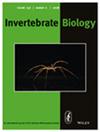Evolutionary derivation of the American lobster cardiovascular system: an hypothesis based on morphological and physiological evidence
IF 1
4区 生物学
Q3 MARINE & FRESHWATER BIOLOGY
引用次数: 23
Abstract
The cardiovascular system of the American lobster includes a large muscular heart that pumps blood into seven arteries, each of which ramifies extensively. Portions of the system may be viewed as relatively primitive, while others are highly derived. We have confirmed earlier findings that the sternal artery is not a single vessel, but a paired structure. The sternal artery and its partner closely resemble the medial branches of the segmental lateral vessels from the dorsal abdominal artery in anterior segments of the abdomen, and they may be homologous. We report that the walls of the dorsal abdominal artery contain blocks of striated muscle cells and that the artery can be induced to contract in response to electrical stimulation or perfusion with proctolin. These observations provide the basis for an attempt to trace the evolution of the heart and arteries from that of primitive malacostracans to its state of development in lobsters. Additional key words: Crustacea, Homarus americanus, evolution, heart, dorsal abdominal artery, sternal artery We present here anatomical and physiological evidence supporting the hypothesis that the cardiovascular system in adult decapod crustaceans, as illustrated for Homarus americanus (e.g., McLaughlin 1983), is derived, by migration and regional specialization, from the evolutionarily primitive plan of a dorsal, longitudinal, tubular, muscular heart with a pair of ostia in each segment running from the head to the telson (Siewing 1963; Hessler et al. 1982). It has been postulated, based on the Cephalocarida, that crustacean ancestors displayed strong serial homology in body plan (Sanders 1955), possibly arising from annelid ancestral antecedants such as an extended nauplius-like larva (Hessler et al. 1982). The Cephalocarida and Branchiopoda (Anostraca, fairy shrimps) are closest to this prototype. This primitive plan is still the general plan in stomatopods (Siewing 1963; McLaughlin 1980). In the ancestral plan, the heart tube lies immediately dorsal to the gut and extends the entire length of the body. The heart tube supplies hemolymph to a short non-muscular anterior median artery to the brain, to some form of serially homologous segmental lateral arterial supply in each body segment, and to an unpaired posterior artery to the telson. The segmental a Author with whom to correspond. lateral arteries are short and do not branch extensively. Paired ostia admit returning hemolymph to the heart tube in each segment. In adults of H. americanus, the single-chambered heart is suspended in the pericardial sinus in the dorsal thorax by several pairs of alary ligaments (Lochhead 1950, pp. 428-431; McLaughlin 1980, pp. 138-141). These elastic ligaments are stretched during systole, and they expand the heart during diastole. During diastole, the heart passively fills with hemolymph from the pericardial sinus through three pairs of muscular,美洲龙虾心血管系统的进化起源:基于形态学和生理学证据的假说
美国龙虾的心血管系统包括一个巨大的肌肉心脏,它将血液泵入7条动脉,每条动脉都有广泛的分支。系统的某些部分可以看作是相对原始的,而其他部分则是高度派生的。我们已经证实了早期的发现,胸骨动脉不是一个单一的血管,而是一个成对的结构。胸骨动脉及其伙伴与腹前段腹背动脉的节段性外侧血管的内侧分支非常相似,它们可能是同源的。我们报道,腹背动脉的壁含有横纹肌细胞块,并且动脉可以在电刺激或灌注proctolin时被诱导收缩。这些观察结果为试图追踪心脏和动脉从原始马甲类动物到龙虾发育状态的演变提供了基础。附加关键词:我们在此提出解剖学和生理学上的证据,证明成年十足甲壳类动物的心血管系统,如美洲Homarus(例如,McLaughlin 1983),是通过迁徙和区域特化,从进化上原始的背、纵、管状、胸骨动脉计划衍生而来的。肌肉心脏,每一节都有一对从头部到心脏的开口(Siewing 1963;Hessler et al. 1982)。有一种假设是,基于头螺类,甲壳类祖先在身体计划上表现出很强的序列同源性(Sanders 1955),可能起源于环节动物祖先的祖先,如扩展的无尾螺类幼虫(Hessler et al. 1982)。头足纲和鳃足纲(anostra,神仙虾)最接近这个原型。这种原始的平面仍然是口足类动物的一般平面(siwing 1963;麦克劳林1980)。在祖先的计划中,心管直接位于肠道的背部,并延伸整个身体的长度。心管向通向大脑的短的无肌前正中动脉供应血淋巴,向身体各节段的某种形式的连续同源节段侧动脉供应血淋巴,并向通向心脏的不配对的后动脉供应血淋巴。段a与之对应的作者。侧动脉短,分支不广泛。成对的开口可使每节段的血淋巴回流到心管。成年美洲美洲人的单室心脏通过几对肋韧带悬浮在胸腔背侧的心包窦中(Lochhead 1950, pp. 428-431;McLaughlin 1980,第138-141页)。这些弹性韧带在心脏收缩期被拉伸,在心脏舒张期扩张。在舒张期,心脏被动地充满来自心包窦的血淋巴,通过三对肌
本文章由计算机程序翻译,如有差异,请以英文原文为准。
求助全文
约1分钟内获得全文
求助全文
来源期刊

Invertebrate Biology
生物-动物学
CiteScore
2.20
自引率
8.30%
发文量
28
审稿时长
>12 weeks
期刊介绍:
Invertebrate Biology presents fundamental advances in our understanding of the structure, function, ecology, and evolution of the invertebrates, which represent the vast majority of animal diversity. Though ultimately organismal in focus, the journal publishes manuscripts addressing phenomena at all levels of biological organization. Invertebrate Biology welcomes manuscripts addressing the biology of invertebrates from diverse perspectives, including those of:
• genetics, cell, and molecular biology
• morphology and biomechanics
• reproduction and development
• physiology and behavior
• ecology
• evolution and phylogenetics
 求助内容:
求助内容: 应助结果提醒方式:
应助结果提醒方式:


